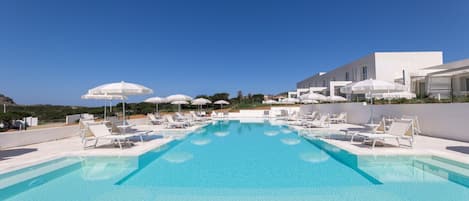Rental basis: Entire house or apartment
Number of bedrooms: 2; Number of other rooms with beds: 1
Number of bathrooms: 1
If you cause damage to the property during your stay, you may be required to pay according to YourRentals’s property damage policy.
On the 1st floor, accessed by a spiral staircase, it consists of a living room with an open kitchen and a sofa bed, a double bedroom, a second bedroom with bunk beds and a bathroom; spacious covered terrace furnished with a table and chairs, with a splendid view of the sea and the Asinara Island. TV, washing machine, dishwasher, and oven; reserved parking space, 300m from La Pelosa beach.
* Check-in: 17:00-21:00 (late check-in 21:00-00:00 > 50eur)
* Check-out: 10:00
* Included:
-Agency fees
-Utility bills
-Final cleaning
* Excluded - Mandatory > In cash upon arrival:
- City tax
- Security deposit: 300eur, to be returned at the check-out, after the apartment inspection
* Excluded - Optional > Upon booking, only on request:
- Bed linen and towels: 20eur per person/week
- One pet allowed: 50eur per pet/week
The holiday home is close to the driveway that leads directly to the famous La Pelosa beach, which is approximately 300 meters away, while the main services are provided by the adjacent shopping center of Capo Falcone. Additionally, the presence of the private parking space eliminates the need to worry about searching for parking and its high daily cost. It is therefore the ideal holiday home for groups of friends as well as for families with young children due to the convenience of quickly reaching the beach without the need for a car.
Lying in the extreme north-western corner of Sardinia, Stintino juts out towards Asinara, almost touching it. Right there, where it almost touches it, it shows its masterpiece, La Pelosa: a limpid and extremely shallow seabed for tens of metres, white and impalpable sand, dazzling and placid sea with all the shades of blue. Next to the ‘big sister’ is La Pelosetta, enclosed by a small island topped by an Aragonese tower (from 1578), the symbol of La Pelosa. From a ‘terrace’ on the ‘tropical’ beach, two hundred metres above sea level, you can enjoy a unique panorama of the unspoilt and wild Isola Piana and Asinara National Park: Stintino is the closest place to visit.
The territory of Stintino is a strip of land between two seas. To the west, the evocative ‘sea outside’, with a high, jagged coastline alternating with sand and pebble coves: from Capo Falcone, a wild place also guarded by a Spanish tower (the highest in the Nurra) and flown over by peregrine falcons and queen's hawks, to Cala del Vapore, through Valle della Luna and Coscia di donna. To the east, the ‘inland sea’, inside the gulf: a low, sheltered coastline that from Pelosa, passing through L'Ancora and the rocks of Punta Negra, reaches the round, white pebbles of the long coastline of Le Saline and Ezzi Mannu. In between is a natural oasis with ponds (Cesaraccio and Pilo), home to red heron, egret and kingfisher.
In the beginning, Stintino was a small fishing village, very similar to Cala d'Oliva on Asinara, the home village of the 45 Ligurian families who founded it in 1885, when the Kingdom of Italy established a lazaret and penal colony on the island, ‘evicting’ the inhabitants. The town, a municipality since 1988, lies on a tongue of land between two inlets - isthintìni means ‘intestines’ - the ‘Old’ and ‘New’ harbours, where wooden Latin-sailed gozzo boats are moored, of which Stintino is the ‘capital’. Since 1983, it has hosted a famous regatta. The town's history is inextricably linked to fishing and tuna processing: relive it in the ‘Tonnare’ museum, located in the ‘Saline’ tuna fishery, active until the 1970s. Once the main source of income, since 2016 it tells the story of Stintino's modus vivendi: you will walk along the ‘chambers’ (the same ones that make up the tuna nets), accompanied by original tools and images. After the tonnara, there is tourism. At the beginning of the 20th century, the village was the destination of illustrious Sassaresi families, such as Berlinguer and Segni, and in the 1960s the boom: a myriad of tourist residences and hotels were built on the coast. The town, inhabited by 1,600 residents in winter, is populated by tens of thousands of tourists in summer. Fishing is the basis of the culinary tradition: octopus in garlic sauce and Stintinese style, lobster soup, tuna roe, seafood and fresh fish, to be savoured in the restaurants in the narrow streets of the village and on the coast















